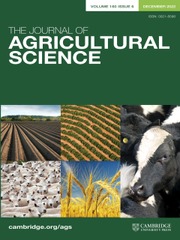Article contents
Estimation of repeatability and phenotypic correlations in Eragrostis curvula
Published online by Cambridge University Press: 01 March 2000
Abstract
Eragrostis curvula (Schrad.) Nees s. lat., a highly polymorphic polyploid complex, can be considered as one of the most important warm season perennial grasses for the semi-arid regions of central Argentina. In apomictically propagated and perennial plants such as weeping lovegrass, where successive measurements can be done across time, repeatability estimates provide an indication of the degree of influence of permanent effects on the phenotypic variation and allow prediction of future performance from past records. Analysis of variance of the experiment showed highly significant variation (P < 0·01) for the main factors in all four traits. Although there was very high variability between cuts, hybrids of E. curvula exhibited considerable inter-entry variability, in particular for those traits determining forage yield. Repeatability calculated in this experiment was highest for the crown diameter (0·86), leaf length (0·84) and dry matter (0·84), while in panicle number (0·66) it was lowest. Repeatability estimates for the vegetative characteristics indicate small effects of temporal environment. The four traits studied, including panicle number with their moderate repeatability, do not require an essentially different number of observations to obtain measures at the same level of accuracy. For vegetative characters two harvests provided 98% of the accuracy of the total obtained with four cuts, and for panicle number the same percentage was obtained for three harvests. This stability of performance is a desirable characteristic for grass cultivars. Patterns of trait associations were also described. Because leaf length is closely associated with dry matter and has high repeatability, to use leaf length as an indirect evaluation criterion should be almost as efficient as direct evaluation for aerial biomass yield. Reliable estimates of parameters such as repeatability and phenotypic correlation are needed for prediction of production values and for the design of efficient improvement programmes. For genotype evaluation additional research is required to quantify the extent of genotype × environment interaction across years and localities of semi-arid regions.
- Type
- Research Article
- Information
- Copyright
- © 2000 Cambridge University Press
- 7
- Cited by




